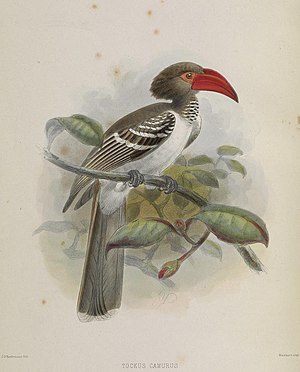Dwarf Toko
| Dwarf Toko | ||||||||||
|---|---|---|---|---|---|---|---|---|---|---|

Dwarf Toko |
||||||||||
| Systematics | ||||||||||
|
||||||||||
| Scientific name | ||||||||||
| Tockus camurus | ||||||||||
| Cassin , 1857 |
The Zwergtoko ( Tockus camurus ), and Red-Zwergtoko or Cameroon Zwergtoko called, one is African bird art that the hornbills belongs (Bucerotidae). Like all species of the genus Tokos , the dwarf Toko is also a cave breeder. The female walls herself up in the nest cavity and is fed by the male during the breeding season.
The population of the dwarf coconut was classified in the IUCN Red List of Threatened Species in 2016 as “ Least Concern (LC) ” = “not endangered”.
features
The dwarf Toko is a small Toko and reaches a body length of up to 30 centimeters. The beak is 5.9 to 9.9 inches long in the males. Females have a significantly shorter beak with a length between 5.4 and 7.6 centimeters. Females are also significantly lighter, weighing an average of 97 grams, while males weigh an average of 111 grams. The sexual dimorphism is only slightly pronounced.
male
In the male, the head, neck, front chest and back are reddish brown. The feathers on the chest have white tips. The tail is dark brown, with the exception of the middle pair, all tail feathers have white tips. The underside of the body is white, the arm and hand wings are dark brown, the individual feathers have a white tip and are lined with white. The feathers of the wings also have a white spot in the middle. The wing covers are dark brown and also have white tips. The beak is red, the low ridge of the beak ends on half of the beak. The orbital ring is dull brown. The eyes are white to pale yellow, the legs and feet are dark brown.
Females and young birds
The females resemble the male in their body plumage. However, they are somewhat smaller, the ridge of the beak is smaller than that of the male and ends at the base of the upper beak. Unlike the males, the beak has a black tip.
Young birds are similar to adult birds, their irises are still gray, the basic color of the beak is orange-red and not red, the featherless facial skin is pale grayish.
Possible confusion
In the distribution area of the dwarf toko, two similarly small species of hornbills occur with the western hard-leaf toko and the congo toko . Both types are predominantly black on the upper side of the body.
distribution
The dwarf Toko occurs in southern Guinea, Liberia, Ivory Coast, Ghana, Togo, Benin, Nigeria, Cameroon, Zaire, western Uganda, Rwanda, the south of the Central African Republic, the south of Sudan and in the north of Angola.
The dwarf coco lives in dense evergreen wet forests of the lowlands. It occurs particularly in swampy areas, but also colonizes forest edges and penetrates into secondary forest. Gallery forests along rivers and isolated patches of forest are also part of his habitat. In Zaire it is still at altitudes of up to 1350 meters.
Way of life
The diet consists of insects , including beetles, praying mantises, crickets, grasshoppers and caterpillars. Occasionally he also eats fruit.
The dwarf Koko occurs in pairs, but much more often in small groups of four to six, in exceptional cases even up to 12 individuals. Presumably this is a social group that defends a territory together - for a Toko species this is a very unusual way of life. Dwarf tokos are most active in the morning and evening hours, while at noon they are mostly hidden in the treetops. They use the lower and middle areas in the forest and often stay on the forest floor. They are often associated with flocks of other bird species, with squirrels and wandering ants . Dwarf tokos benefit from the insects that scare away these other species.
Reproduction
Little is known about the reproduction of the dwarf coconut. In Liberia a female ready to breed was observed in June and in Burkina Faso in August near a breeding cave. In Zaire, chicks were found in a nesting hole in November, which indicates a laying time in September.
Basically, the dwarf Toko, like all Toko species, is a cave breeder. It only breeds in natural tree hollows, the entrance is sealed by the female except for a narrow gap.
literature
- W. Grummt , H. Strehlow (Ed.): Zoo animal keeping birds. Verlag Harri Deutsch, Frankfurt am Main 2009, ISBN 978-3-8171-1636-2 .
- Alan Kemp: The Hornbills - Bucerotiformes . Oxford University Press, Oxford 1995, ISBN 0-19-857729-X .
- Gordon Lindsay Maclean: Robert's Birds of South Africa , 6th Edition
Web links
- Lophoceros camurus in the endangered Red List species the IUCN 2012. Posted by: BirdLife International, 2012. Accessed October 21, 2016th
Single receipts
- ↑ Lophoceros camurus in the endangered Red List species the IUCN 2016 Posted by: BirdLife International, 2016. Retrieved on 3 October 2017th
- ↑ Kemp: The Hornbills - Bucerotiformes . P. 148.
- ↑ Kemp: The Hornbills - Bucerotiformes . P. 147.
- ↑ a b Kemp: The Hornbills - Bucerotiformes . P. 149.